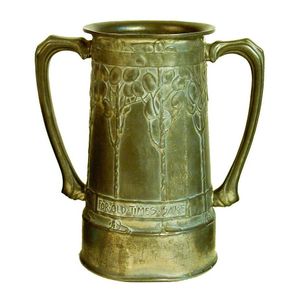Austrian Silver Cream Jug with Gadrooned Border
You must be a subscriber, and be logged in to view price and dealer details.
Subscribe Now to view actual auction price for this item
When you subscribe, you have the option of setting the currency in which to display prices to $Au, $US, $NZ or Stg.
- Floral Swag / Garland / Festoon - Floral swags are a decorative motif often used in the ornamentation of various objects, such as silverware, glassware, and furniture. The term "swag" refers to a garland or wreath of flowers, foliage, or other decorative elements, which is usually arranged in a loop or curve.
Floral swags can be found in a variety of decorative styles, from ornate Baroque and Rococo designs to more naturalistic Art Nouveau and Art Deco styles. They are often used to add a touch of elegance, refinement, or whimsy to an object, and can be seen on a range of items from chandeliers and candlesticks to picture frames and tea sets.
In the decoration of silver objects, floral swags are often used to accentuate the curves and lines of the piece, and to add visual interest to the surface. Similarly, on glass objects, floral swags may be used to frame or highlight a particular area of the object, or to add a touch of color and delicacy.
On furniture, floral swags can be found on a variety of pieces, from cabinets and armoires to chairs and sofas. They are often used to enhance the lines and curves of the furniture, and can be used to create a sense of movement and flow in the design.
Overall, floral swags are a versatile decorative element that can be adapted to a range of styles and applications, and have been used in the decoration of various objects throughout history. - Circa - A Latin term meaning 'about', often used in the antique trade to give an approximate date for the piece, usually considered to be five years on either side of the circa year. Thus, circa 1900 means the piece was made about 1900, probably between 1895 and 1905. The expression is sometimes abbreviated to c.1900.
- Gadrooning - A series of lobes usually as a border. In furniture gadrooning is found as carved decoration around the edges of table tops in the Chippendale and Jacobean style furniture. Gadrooning is also found as decoration on the rims of silver and ceramics.
This item has been included into following indexes:
Visually similar items

A German silver hallmarked Christening cup decorated in a floral continious band. 'Gretl' to the front shield. 7.5 cm high. 88 grams in weight

An early Victorian silver tankard, one quart, plain traditional form with acanthus leaf thumb piece, Spencer family armorial to the front. Sheffield 1856 by Henry Wilkinson. Weight 814gms. Height 21 cm

An Edward VI Britannia standard silver tankard of Charles II style, with tapering sides, double-scroll thumb piece and acanthus leaf junction to handle, and McPherson coat of arms which reads 'Touch Not the Cat But a Glove'. Maker: HF, London, 1908, 756gm.

David Veasey for Liberty & Co. pewter twin-handled loving cup, Model No. 010, decorated with honesty plants and the verse 'For Old Times Sake'. Embossed 'English Pewter' and model number to the base. Height 20 cm
